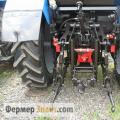Page 7
Transport »Project of a service station with the development of a site for repairing the undercarriage of passenger cars for the State Institution" Primorye "sanatorium st. Okeanskaya Vladivostok "Determination of the need for electricity, heat and water
The first suspension with variable ground clearance for a passenger car was created by the French company Citroen. Compressed nitrogen served as the elastic element in the shock absorbers, and the fluid (generating and transmitting pressure in the system) was used. Therefore, this suspension is called hydropneumatic. The hydraulic pump pumps liquid from the reservoir, and the spheres fixed next to the shock absorber. Inside each, liquid and gas are separated by a membrane. Thus, the required pressure is maintained in the shock absorbers, and the rolls of the machine are constantly compensated. In addition, a valve built into the hydraulic system allows you to regulate the amount of fluid circulating in the circuits, and therefore, increase or decrease the ground clearance.
In 1954, this scheme was first used on the high-end model Citroen 15-6. And already in October 1955, the company's novelty - "Citroen DS" - caused a real sensation at the 42 Paris Motor Show. In those days it was a miracle machine. Its hydropneumatic suspension provided constant ground clearance regardless of the number of passengers and luggage, and an amazingly smooth ride. This car could tilt forward and backward, as well as hang out any wheel without a jack! And finally, the driver of "Citroen DS" could stepwise change the ground clearance at his own discretion. This not only increased the stability and active safety of the car on the highway (the center of gravity was lowered, the air flow under the bottom, which creates lift, decreased), but also facilitated off-road driving, which is important for France, which is full of country roads.
Subsequently, such a suspension scheme was used on most Citroen cars and was improved all the time. The latest development of the company - the "Hydroactive III" suspension, is electronically controlled by sensors, a computer and actuators. As a result, the clearance of the Citroen C5 model is not only maintained, but also automatically adjusted depending on the driving speed, the quality of the road surface and the driving style. The range of changes in ground clearance reaches 20-30 mm. Citroen made the hydropneumatic suspension its “hobbyhorse”, being the first to use it. However, a similar suspension "Hydrolastic" was once installed on its small cars by the English "British Leyland Motor Corp.", and "Lotus" developed hydropneumatics for the "Scorpion" reconnaissance tank.
In Russia, an airborne combat vehicle (BMD) with a hydropneumatic independent suspension of all rollers has been produced since 1968 by the Volgograd Tractor Plant. The car had to lower the bottom of the body to the ground in order to better on the ground and easier to load onto the plane. Many companies have been exploring the possibilities of using a pure air suspension in passenger cars. For example, in the 1960s, Daimler-Benz (Mercedes-Benz 600 and Lincoln equipped production models with it. And the first SUV equipped with airbag suspension, replacing springs, was in 1992 the Range Rover LSE. ”Large studies in this area were carried out in the 70s by Volkswagen and Audi together with the company Fichtel und Sachs.
As a result, since the spring of 2000, Audi has launched on the market a full-free Allroad model with independent air suspension of wheels, equipped with an electronic control unit. At speeds above 120 km / h, the clearance is set to 142 mm, at 80 km / h -167 mm, and below the car rises 192 mm above the road. In addition to automatic change of clearance, manual change is possible, allowing the driver to "lift" the car to a height of 208 mm.
The air suspension design of the all-wheel drive Volkswagen AAC concept car is similar to the Audi Allroad: it has an independent long-travel suspension on double wishbones. The range of ground clearance with three fixed positions is simply enormous - from 280 mm to 390 mm. Currently, Toyota offers the Automatic High Control (AHC) system as an option for its Land Cruiser 100 SUV (aka Lexus LS400). The change in clearance occurs in four fixed positions 50 mm down or up from the base value of 220 mm. Switching positions occurs within 7 seconds after the driver presses a button on the center console.
Input steerable blades
To achieve the required gas flow, the compressor has controllable inlet vanes located at the suction. The blades are pneumatically controlled, which receives a signal from the flow indicator. Changing the position of the blades is possible when they move from -30 degrees to +80 degrees. This position is shown both locally and in PUGO (from 0 to 100 ...
The results of the economic development of Chelyabinsk
Table 1 Main indicators of social and economic development of Chelyabinsk rev. 2010 2010 in% to 2009 Goods of own production were shipped, works and services were performed on their own for “pure” types of activity in current prices mln.rub. 307 776.5 135.7 Production index as% of the previous year ...
Ethanol and methanol
Ethanol (drinking alcohol), which has a high octane number and energy value, is extracted from waste wood and sugar cane, provides the engine with high efficiency and low emissions, and is especially popular in warm countries. So, after its 1973 oil crisis, Brazil actively uses ethanol - there are more than 7 ...
One of the main parameters of any car, along with the length, wheelbase length and width, is ground clearance, which is also called ground clearance. What it is?
Ground clearance is the distance between the road surface and the lowest point on the underside of the vehicle. This indicator affects the passability of the car, the greater the clearance, the more uneven roads your car will be able to drive without damaging the engine crankcase and bumper.
How do I change the ground clearance?
The desire to change the size of the ground clearance occurs in the following cases:
- to increase cross-country ability, if you constantly drive on dirt roads, the clearance is increased;
- to improve stability on the track, the clearance, on the contrary, is lowered.
It is worth noting that a deviation from the passport data of the car affects handling, speedometer and sensor readings.
The easiest way is to install a low or high profile rubber. However, just changing the tires is not enough, you will also need to file and widen the wheel arches, and in some cases completely change the gearbox to reduce / increase the gear ratio.
You can also increase the ground clearance by installing spacers. They are installed between the supporting parts of the struts and the body. Another way is to install rubber seals-spacers between the coils of the shock-absorbing springs. It is clear that ride comfort will decrease - the suspension will become stiffer and you will literally feel every hole.
Each specific case needs to be calculated in different ways. To solve your specific problem, you need to come to us by car and consider the options that suit you.
Change of clearance with a button
This is not about air suspension, but about traditional coilovers, where hydraulics allow the lower spring seat to be raised or lowered. The goal is to increase the ground clearance (by 45 mm) so as not to catch the curb with the front overhang and not to damage the expensive body kit. Last year KW made the HLS system available to owners of expensive cars like the Porsche 911. Now it can be installed on any car with coilovers (the cheapest option is to install a system for changing the clearance and replacing the springs while keeping the standard shock absorbers). The tuning studio did not stand aside - for example, Cargraphic under the Airlift brand offers a similar system that is compatible with Bilstein struts.
 Optics with LEDs
Optics with LEDs
Angel Eyes, which have been a hit on the tuning market for a good ten years, are gradually losing their status as a cult device. Now everyone is drying on the LED daytime running lights, which Audi has pioneered in its latest models. Among the tuners, such optics have already received the nickname devil eyes, that is, "the eyes of the devil." The list of models for which such a solution is available is expanding weekly.
 Discs with "swastika"
Discs with "swastika"
Dotz's Hanzo CD, which debuted last year, was damn successful and was immediately copied by competitors. This year, at the exhibition stands, one could count about ten models with a similar design, which is used even by famous ateliers - for example, by Carlsson in the 1/5 Revo model. Our attention was drawn to concept discs (that is, not yet launched into production) of a little-known brand GMP Italy, whose designers tried to creatively rethink the swastika, and not just transferred the pattern they liked to their own blank.
The cryptic term "clearance" is defined as the distance from the road surface to the bottom of the vehicle. That is why, instead of the concept of clearance, the phrase "ground clearance" is often used. But in addition to what is the clearance of a car, it is important to know a number of other parameters directly related to this concept.
The amount of clearance depends on the type of vehicle and its design. The ground clearance of SUVs, the main task of which is cross-country ability, tends to a reasonable maximum, averaging 300 mm. For cars with "sports genes" the most important goal is to lower the center of gravity, which significantly improves handling and is mainly determined by the proximity to the roadway. They have a clearance value of about three times less than that of SUVs.
For passenger cars, with their practicality and asphalt "habitat", the ground clearance is somewhere in the middle and is about 150 mm. The most compromise option is the crossover clearance, which is about 200 mm. This ground clearance, combined with a relatively stiff suspension, determines the behavior of the car, instilling confidence in the driver, both in high-speed cornering and on moderate off-road conditions. Add in the ease of curb parking and improved visibility. It's no wonder crossovers are so popular. Although, in fairness, it must be said that the clearance of passenger cars adapted for our roads is often no less than that of crossovers. So for VW Polo it is 17 cm, for Citroen C4 Sedan and Peugeot 408 - 17.5 cm, and for Lada Vesta - almost 18 cm!
Comparative vehicle clearance is a loose concept. So for some cars it can be "floating", ie. changeable. For this, the machine is equipped with hydropneumatic or air suspension. The range of change in clearance for cars with such a system is quite wide. It satisfies the ambition of both the rider and the cross-country enthusiast. This option could be considered optimal if it were not for the high price of a car with an adjustable suspension. By the way, despite the bad roads, the low ground clearance in our country even has its own caste of fans - the BPAN community and the like, where car owners achieve a beautiful low landing of their cars due to handicraft installed pneumatic bellows.
If desired, the vehicle's clearance can be changed by quite affordable methods. To reduce the clearance, the springs are replaced with shorter ones or they are trimmed. There are not many connoisseurs of scanty ground clearance. There are many more who want to increase it. The easiest way is to install larger diameter wheels. However, the choice of a non-standard wheel should be taken with great care. Otherwise, there is a high risk of rubbing the tire against the body when cornering. In addition, you should immediately come to terms with the distortion of the speedometer, odometer readings and the incorrect operation of some electronic systems. You can increase the ground clearance using turn-to-turn spacers (1000-3000 rubles per pair), which reduce the compression of the springs. Only in combination with the inevitable in this case a decrease in the shock absorber travel, this method, although budgetary, affects the car's handling for the worse. As well as replacing non-standard springs.
The most common is the use of spacers between the strut support and the body. Spacers can be made of rubber, polyurethane, aluminum, etc. They differ from each other in price and quality. So, rubber is more accessible (500-1000 rubles), but less wear-resistant. Polyurethane (1000-4000 rubles) last longer, but more expensive and can deform the body. And aluminum (1000-2000 rubles) can cause corrosion at the junction. It should be borne in mind that an increase in ground clearance of more than 30-40 mm threatens the unpredictability of the car's behavior on the road, especially when cornering, as well as increased wear and tear of some parts of the undercarriage, for example, expensive CV joints, due to the increased angle of the drive shafts.
Before embarking on radical transformations to increase the vehicle's clearance, it will be useful to study its bottom on a lift. Depending on the design, it can have many protruding parts or be relatively smooth. Perhaps, based on the results of the "revision", it will be possible to calculate the weak points of the structure and develop an individual style of operation, taking into account the available standard clearance. In addition, you should remember about the size of the wheelbase. Sometimes a car with low ground clearance and a short wheelbase is more passable than its long-wheelbase opponent with impressive ground clearance.
And further. Although the crankcase is usually the lowest point on the machine, it should be protected with metal or Kevlar shields. Yes, the ground clearance in this case will decrease by 10-15 mm, but insurance will appear against unforeseen crankcase breakdown and, as a result, expensive repairs.
The car is designed to move on the road. But lately we have to do this on the road, and sometimes it is difficult to determine where one ends and another begins. Therefore, such an automobile characteristic as ground clearance is of great interest among car owners. This article shows the dimensions in the comparative table of vehicle clearance, but first, of course, you should figure out what it is and what functions it performs.
The ground clearance is explained by GOST as the distance between such parts of the car as the supporting surface and the lowest point of the central part of the entire structure. In simple terms, it is the distance that separates the perspective of damage to the very bottom of the vehicle and the road surface. More often this concept can be heard in such a form as ground clearance - it is more understandable, easier to remember and therefore it is used with great pleasure.
The amount of ground clearance is a very important characteristic for any car, as it significantly affects stability at high speed, cross-country ability, and maneuverability. And these are, without a doubt, those indicators that can demonstrate the car in the best possible light. As for the passability, it can be increased along with an increase in the value. By the way, you can do this while driving - on some cars.
As a rule, ground clearance is indicated in millimeters, sometimes also in centimeters. The practice of notifying car owners about two values \u200b\u200bis also widespread - the clearance under the axle of the front and rear location. Sometimes they even indicate the clearance under the crankcase.
In order to make it easier to characterize the clearance, in the future and with the help of a table, a conditional classification of this characteristic should be given. In general, the ground clearance can be divided into three categories: large (SUVs and SUVs), medium (crossovers and SUVs), and small (passenger cars). Now for the specific ground clearance values \u200b\u200bunder the front bumper:
- 20-35 cm for SUVs.
- Not less than 18 cm and not more than 25 cm for SUVs.
- 14-20 cm for "cars".
As for the oil pan, these are the values: 
- From 20 cm for SUVs;
- From 17 to 21 cm for SUVs;
- 12 to 17 cm for passenger cars.
Comparative table of car clearance
A comparative analysis of the ground clearance of various cars allows us to conclude all these values \u200b\u200bin the table, which is given in this material. The table will show the lowest and highest ground clearance values \u200b\u200bof all three groups of cars, given earlier. 
The list of SUVs characterized by the highest value, without a doubt, should include the following: Land Rover Defender (25 cm - under the front bumper, 43 cm - under the fuel tanks), UAZ Hunter (20.5 / 40 cm), Nissan Patrol Y62 ( 28.5 / 30.5 cm), Mercedes-Benz GL500 (28.5 / 29.7 cm), Volkswagen Touareg (26.5 / 30 cm).
As for SUVs and crossovers, here the table can be explained by two criteria: cars with a ground clearance of less than 18 cm and more than the same value.
The first group includes the following models: Infiniti EX (14.7 cm), Honda CR-V and Nissan Juke (17 cm), Kia Sportage (17.2 cm), Lifan X60 (17.9 cm), Skoda Yeti and SsangYong Actyon (18 cm).
Second group: Hyundai Santa Fe and Kia Sorento (18.5 cm), Chery Tiggo and Suzuki SX4 (19 cm), Mitsubishi ASX (19.5 cm), Toyota RAV4 (19.7 cm), Suzuki Grand Vitara, Volkswagen Tiguan and Nissan Qashqai (20 cm), Renault Koleos (20.6 cm), Mazda CX-5, Nissan X-Trail and Renault Duster (21 cm), Range Rover Evoque (21.2 cm), Subaru Forester and Mitsubishi Outlander ( 21.5 cm), Subaru XV and Land Rover Freelander (22 cm).
The group of average passenger cars, the indicator of which is in the range of 14-20 cm, includes the following: Chevrolet Cruze and Daewoo Matiz (15 cm), Kia Spectra (15.5 cm), Lada Kalina (15.8 cm), Chevrolet Lanos and Hyundai Solaris (16 cm), Volga GAZ-24 (17.4 cm), Hyundai ix35 (17.5 cm), VAZ-2110 (18 cm), Renault Sandero Stepway (19.5 cm).
Renault Duster and SsangYong Kyron (21 cm), Ford Explorer (21.1 cm), Toyota Land Cruiser 200 (22.5 cm) fall into a separate category of "cars", the ground clearance of which exceeds 20 cm, and UAZ breaks all records -469 with a value of 30 cm.
Speaking about the highest values \u200b\u200bof ground clearance, such a serial vehicle as a row-crop tractor should be noted. Their clearance can reach 50-70 cm, and even 200 cm for special ones.
 This comparative analysis showed that clearance is an individual indicator of each vehicle. Despite the fact that, depending on the purpose of the car, its dimensions and other features, the ground clearance can be combined into three groups, this distribution is still conditional. First of all, due to the fact that depending on the models, the clearance, for example, in cars can reach values \u200b\u200beven higher than that of crossovers. Therefore, motorists, before buying themselves another car novelty, are advised to check the clearance values \u200b\u200b- this is in their own interests.
This comparative analysis showed that clearance is an individual indicator of each vehicle. Despite the fact that, depending on the purpose of the car, its dimensions and other features, the ground clearance can be combined into three groups, this distribution is still conditional. First of all, due to the fact that depending on the models, the clearance, for example, in cars can reach values \u200b\u200beven higher than that of crossovers. Therefore, motorists, before buying themselves another car novelty, are advised to check the clearance values \u200b\u200b- this is in their own interests.
Video "Increasing the ground clearance of the front suspension"
The recording shows how the repair work is going on to raise the Renault Duster front suspension (20 mm).




